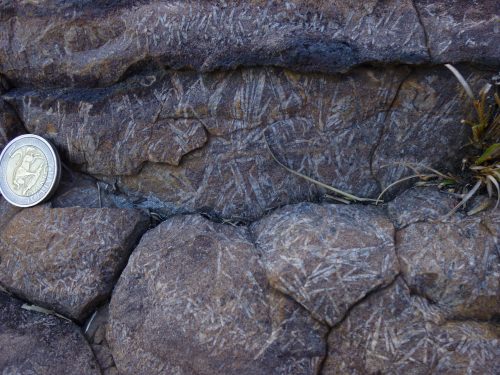-
Life in Ancient Oceans Enabled by Erosion from Land
November 07, 2016 / Written by: David Tenenbaum
Aaron Satkoski used the UW-Madison Department of Geoscience's mass spectrometer to measure isotopes in samples collected from South Africa. Image credit: David TenenbaumAs scientists continue finding evidence for life in the ocean more than 3 billion years ago, those ancient fossils pose a paradox.
Organisms, including the single-celled bacteria living in the ocean at that early date, need a steady supply of phosphorus, but “it’s very hard to account for this phosphorus unless it is eroding from the continents,” says Aaron Satkoski, a scientist in the geoscience department at the University of Wisconsin–Madison. “So that makes it really hard to explain the fossils we see at this early era.”
Satkoski, who is first author of a new report on ocean chemistry from this remote period, says the conventional wisdom of geology has envisioned an oceanic planet, with little or no land above the waves. “Starting back in the 1960s, for various reasons people claimed there was very little continental mass, and so there wasn’t enough weathering to affect the chemistry of the ocean. But there wasn’t much real data from more than 3 billion years ago to support that.”

This sample of 3.26-billion-year-old barite shows the granular barite (gray-green areas) that was influenced by ocean water, and bladed barite (vertical black bands) that was by ocean water and water circulating below the sea floor. David TenenbaumDiscoveries of fossil remains of bacteria from over 3 billion years ago have changed that picture, says Satkoski. “But if there was life in the ocean, you need some amount of continental weathering taking place to deliver phosphorus so the organisms can live.”
The major influences on ocean chemistry today are hydrothermal flow (hot water that has circulated through the crust) and surface weathering (the river transport of material eroded from land into the ocean).
To evaluate each influence 3.26 billion years ago, geoscience Professor Clark Johnson and Satkoski collected samples from South Africa and compared isotopes in two forms of a rock called barite. The cemented granules had formed in the water, then fused after dropping to the ocean floor.
A solid, or bladed, type of barite had formed at the ocean floor. Johnson, Satkoski and colleague Brian Beard assumed that the granular rock would reflect ocean water chemistry, and therefore any eroded, continental material. The bladed barite would represent a mix of ocean chemistry and hydrothermal flow.

Field photo of barite. Barite blades are seen as white linear structures and granular barite fills the space in between the blades. Aaron Satkoski, UW–MadisonThe study hinged on precise measurements of isotopes — atoms that are chemically identical but that have different masses. Knowing that strontium derived from land shows a slightly higher ratio of strontium 87 than strontium derived from hydrothermal circulation, the scientists compared isotopes in each type of barite.
The result was a nearly infinitesimal — but still significant — difference in the isotope ratios, signifying that the granular barite indeed was derived from sediment eroded from land. In other words, a significant amount of erosion was taking place 3.26 billion years ago.
Their report, published online by Earth and Planetary Science Letters, pushes back the first solid date for large-scale continental erosion by 400 million years.
“It’s a guess how much of the planet’s surface was land, but it could be as high as two-thirds of the area of today’s continents,” says Johnson, who leads the NASA Astrobiology Institute at the University of Wisconsin. “Some previous estimates had no continents at all.”
“When people were thinking about ocean chemistry, it was always centered on hydrothermal flow, but there was little data,” Johnson says. “We are trying to put some data into the equation.”
Read the full story at the University of Wisconsin-Madison.
This research was funded by the NASA Astrobiology Institute and the National Science Foundation.
Source: [University of Wisconsin-Madison]
- The NASA Astrobiology Institute Concludes Its 20-year Tenure
- Global Geomorphologic Map of Titan
- Molecular Cousins Discovered on Titan
- Interdisciplinary Consortia for Astrobiology Research (ICAR)
- The NASA Astrobiology Science Forum Talks Now on YouTube
- The NASA Astrobiology Science Forum: The Origin, Evolution, Distribution and Future of Astrobiology
- Alternative Earths
- Drilling for Rock-Powered Life
- Imagining a Living Universe
- Workshops Without Walls: Astrovirology